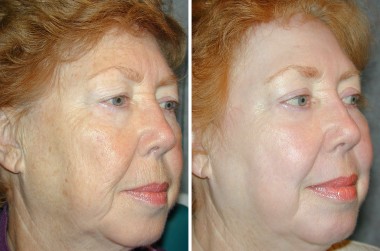What is Laser Skin Resurfacing

Laser Skin Resurfacing is a method for smoothing scars, ACNE pitting, WRINKLES, and other blemishes from the SKIN, primarily on the face, using a heat (usually carbon dioxide) laser. The laser focuses a high-intensity beam of light that the dermatologist moves across the surface of the skin, precisely targeting the depth and skin areas for resurfacing. This precision control allows the dermatologist to target some areas more deeply than others, accommodating such variations in the skin as fine wrinkles to moderate scars. Like CHEMICAL PEEL and DERMABRASION, laser skin resurfacing achieves skin smoothing by destroying layers of cells. The new skin that grows to replace the destroyed skin is tight and smooth.
The dermatologist performs laser skin resurfacing as an AMBULATORY SURGERY procedure in a clinic, office facility, or an ambulatory surgery facility, typically using local anesthetic to numb the skin and a sedative medication for relaxation and improved comfort. The length of time the procedure requires depends on what kinds of blemishes the dermatologist is treating. The dermatologist may cover the treated surfaces with an ointment and bandages, which remain in place for one or two days.
After the procedure the treated skin surfaces are red, swollen, and tender or painful. After a day or two the skin scabs or crusts, a normal stage in the HEALING process. The dermatologist removes any bandages at this time. As the skin heals the scabs fall away, typically in 10 to 14 days. The new skin is red and shiny, transitioning to normal pigmentation and texture over the following six to eight weeks (though most of the redness subsides in about three weeks). Full HEALING and noticeable improvement take about six months.
The Risks of Laser Skin Resurfacing
The risks of laser skin resurfacing are slight and include excessive bleeding, INFECTION, and pigmentation changes. As with all cosmetic procedures, it is important to fully understand what laser skin resurfacing can and cannot accomplish. Most people who receive treatment from a qualified dermatologist or plastic surgeon are satisfied with the results. Some people may find that the new skin is sensitive to soaps, cleansers, and makeup used before the procedure.
Laser Skin Resurfacing and Protective Clothing
The new skin is very vulnerable to damage from the sun during as well as after healing, requiring protective clothing, such as a widebrimmed hat or scarf, and high sun protection factor (SPF) sunscreen whenever sun exposure is necessary. The effects of laser skin resurfacing typically last several years, with wrinkles gradually returning as a normal function of the aging process. Alterations such as SCAR revision or removal are permanent.
See also AGING, INTEGUMENTARY CHANGES THAT OCCUR WITH; BOTULINUM THERAPY; LASER SURGERY; SUN PROTECTION; SURGERY BENEFIT AND RISK ASSESSMENT.